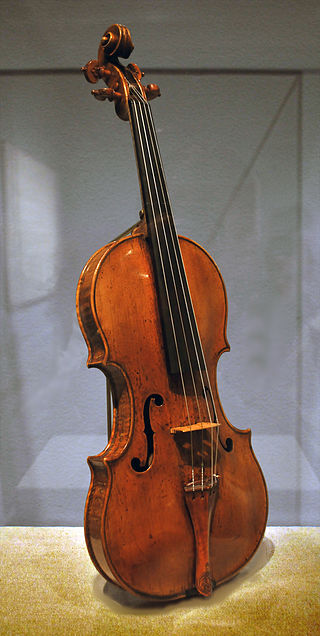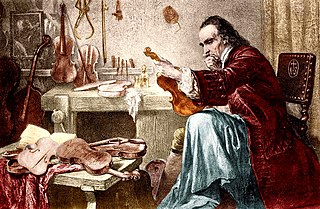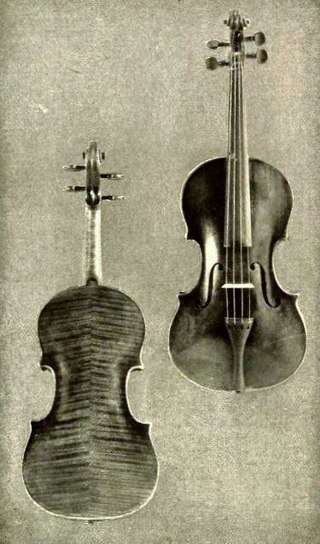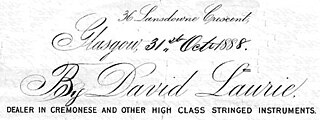Related Research Articles

Amati is the last name of a family of Italian violin makers who lived at Cremona from about 1538 to 1740. Their importance is considered equal to those of the Bergonzi, Guarneri, and Stradivari families. Today, violins created by Nicolò Amati are valued at around $600,000. Because of their age and rarity, Amati instruments are mostly kept in museum or private collections and are seldom played in public.

Antonio Stradivari was an Italian luthier and a craftsman of string instruments such as violins, cellos, guitars, violas and harps. The Latinized form of his surname, Stradivarius, as well as the colloquial Strad are terms often used to refer to his instruments. It is estimated that Stradivari produced 1,116 instruments, of which 960 were violins. Around 650 instruments survive, including 450 to 512 violins. His instruments are considered some of the finest ever made, and are extremely valuable collector's items.

A Stradivarius is one of the violins, violas, cellos and other string instruments built by members of the Italian family Stradivari, particularly Antonio Stradivari, during the 17th and 18th centuries. They are considered some of the finest instruments ever made, and are extremely valuable collector's items.

Giovanni Battista Guadagnini was an Italian luthier, regarded as one of the finest craftsmen of string instruments in history. He is widely considered the third greatest maker after Antonio Stradivari and Giuseppe Guarneri "del Gesù". The Guadagnini family was known for their violins, guitars and mandolins.

Jean-Baptiste Vuillaume was a French luthier, businessman, inventor and winner of many awards. His workshop made over 3,000 instruments.

Carlo Bergonzi was an Italian luthier and is the first and most prominent member of the Bergonzi family, a distinguished group of luthiers from Cremona, Italy, a city with a rich tradition of stringed instrument makers. Today his instruments are highly valued for their workmanship and tone. Although he was historically assumed to have first apprenticed with Hieronymus Amati or Antonio Stradivari, he is now known to have been the student of Vincenzo Rugeri.

The Lipinski Stradivarius is an antique violin constructed in 1715 by the Italian luthier Antonio Stradivari of Cremona, during Stradivari's "golden period" between 1700 and 1725. There are fewer than 650 extant Stradivarius violins in the world today, and the Lipinski is considered to be a particularly fine example. In 2012, it was appraised at US$5 million.
The Otto Booth; Cho-Ming Sin Stradivarius of 1716 is an antique violin fabricated by Italian luthier Antonio Stradivari (1644–1737) of Cremona. The original label of the instrument was "Antonius Stradivarius Cremonensis faciebat Anno 1716". The Booth Stradivarius has a two-piece back and has a body length of 35.4 cm.

The Stradivari Society is a philanthropic organization based in Chicago, Illinois, best known for its arranging deals between owners of antique string instruments such as those made by luthiers Antonio Stradivari and Giuseppe Guarneri, for use by talented musicians and performers. The Stradivari Society does not hold title to the instruments.

Bartolomeo Giuseppe "del Gesù" Guarneri was an Italian luthier from the Guarneri family of Cremona. He rivals Antonio Stradivari (1644–1737) with regard to the respect and reverence accorded his instruments, and for many prominent players and collectors his instruments are the most coveted of all. Instruments made by Guarneri are often referred to as Del Gesùs.
Francesco Rugeri, also known as Ruger, Rugier, Rugeri, Ruggeri, Ruggieri, Ruggerius, was the first of an important family of luthiers, the Casa Rugeri in Cremona, Italy. His instruments are masterfully constructed. His violins are inspired by Nicolò Amati's "Grand Amati" pattern. Francesco was the first to develop a smaller cello design, which has become the standard for modern cello dimensions. Today, Rugeri's instruments are nearly as renowned as Nicolò Amati's instruments.
Samuel Zygmuntowicz is a contemporary luthier and is widely regarded as one of the finest violin makers of his generation. He began his instrument making training at age 13, and studied making and restoration under Peter Prier, Carl Becker and René Morel. Since 1985 he has been based in Brooklyn, New York. His early work demonstrates expert skill as a copyist of classic instruments. Later work includes personal models informed by intensive advanced research. Findings from this research have been published in numerous print and digital media. Zygmuntowicz is an active fiddler, playing with several folk music groups. His playing can be heard on the recordings Grand Picnic, and Jump When the Trumpets Blow.

The Lord Dunn–Raven Stradivarius of 1710 is an antique violin made by luthier Antonio Stradivari of Cremona (1644–1737). It is one of 700 known existent Stradivari instruments. This violin is currently owned by violinist Anne-Sophie Mutter. The Lord Dunn-Raven was made during the Stradivari's "golden period". The violin is named after the Irish politician Windham Wyndham-Quin, 4th Earl of Dunraven and Mount-Earl.

David Laurie - was a distinguished 19th century violin collector.

Hottinger Collection – formed in New York City by Henry Hottinger.
Giuseppe Giovanni Battista Guarneri, better known as Giuseppe filius Andrea Guarneri was a violin maker from the prominent Guarneri family of luthiers who lived in Cremona, Italy.

Tarisio is the world's largest seller of fine stringed instruments and bows. Founded in 1999 as an auction house that specializes in string instruments and bows, Tarisio now has locations in New York, London and Berlin and serves a global clientele.

Nicola Amati, Nicolò Amati or Nicolao Amati was an Italian master luthier from Cremona, Italy. Amati is one of the most well-known luthiers from the Casa Amati. He was the teacher of illustrious Cremonese School luthiers such as Andrea Guarneri and Giovanni Battista Rogeri. While no clear documentation exists for their being apprentices in his shop, Amati may also have apprenticed Antonio Stradivari, Francesco Rugeri, and Jacob Stainer, as their work is heavily influenced by Amati.
Vincenzo Rugeri, was an Italian luthier of string instruments such as violins, cellos, and, violas in Cremona, Italy. His instruments are noted for their craftsmanship and tone quality. Vincenzo came from a distinguished family of luthiers, the first of whom was his father, Francesco Rugeri. Despite the local tradition of artisan families laboring together through generations, Vincenzo left the family shop and set up a successful shop of his own in the center of Cremona. Vincenzo was the third son of luthier Francesco Rugeri. Vincenzo's work, like Francesco's, is influenced by Nicolò Amati's Grand Pattern model, however Vincenzo's work was distinguished from his father's by utilizing a lower arch inspired by Antonio Stradivari. An analysis of the body of his work reveals that the quality of Vincenzo's instruments is remarkable, perhaps even more so than his father's. Vincenzo's instruments, though less numerous, are valued at least equal to those of his father. A violin by Vincenzo Rugeri realized $502,320 on October 3, 2011 at Brompton's Auctions in London. Carlo Bergonzi was a distinguished apprentice of Vincenzo Rugeri.
References
- ↑ "What Musicians Want in a Stringed Instrument". Journal of the Violin Society of America. 19. United States: Violin Society of America: 9. 2004.
- ↑ Grossman, Ron (December 10, 1992). "SOUND AND FURY". The Chicago Tribune. Retrieved February 21, 2023.
- ↑ Wakin, Daniel (May 11, 2008). "Time to Tie a String Around That Strad". The New York Times. Retrieved February 21, 2023.
- ↑ "Violin dealer Geoffrey Fushi dies in Chicago". The Strad. April 16, 2012. Retrieved February 21, 2023.
- ↑ Holm, Carsten (January 4, 2008). "Mad about Strads: Fiddling the Stradivarius Market". Spiegel International. Retrieved February 21, 2023.
- ↑ "About". Fein & Bushi. Retrieved February 22, 2023.
- ↑ "Selected Notable Sales". Bein & Fushi. Retrieved February 22, 2023.
- ↑ Karel, Janna. "Lord of the strings Prized Stradivarius violins take center stage in Las Vegas". Las Vegas Review Journal. Retrieved February 22, 2023.
- ↑ Rhein, John von (July 13, 1996). "Pulling Strings". Chicago Tribune. Retrieved February 21, 2023.
- ↑ Pilkington, Ed (July 5, 2010). "Asking price would make Vieuxtemps Guarneri the most expensive musical instrument ever". The Guardian. Retrieved February 21, 2023.
- ↑ "Antonio Stradivari, Cremona, 1734, "Willemotte"". Tarisio.